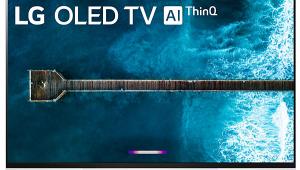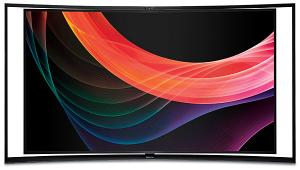Samsung 32" Odyssey OLED G80SD Monitor Review: Picture Perfect

AT A GLANCE
Plus
Superb SDR and HDR picture quality
Low input lag and Game Bar
Attractive design, easy assembly
Extensive and responsive smart TV features
Minus
Peak brightness could be higher
A bit pricey for a 32" display
THE VERDICT
The Samsung Odyssey OLED G80SD is a premium, 32-inch 4K smart monitor that is a feature-packed, state-of-the-art visual powerhouse with a slick, modern design. It looks fantastic, supports a variety of sources, and delivers exceptional picture quality.
Simply calling the G80SD a monitor doesn't do it justice because it offers so much functionality; it is a lot like a Samsung TV. It's also a gamer's dream machine thanks to its support for up to 240Hz refresh rates and VRR (variable refresh rate). It comes with a convenient remote, as well as support for Alexa and Bixby voice assistants.
Its built-in streaming abilities are extensive. You get an experience very similar to a 2024 Samsung TV. You even get the same in-depth calibration controls as Samsung's TVs. Plus, this monitor is notably accurate right out of the box because it comes factory-tuned.
Features
This monitor's feature list is incredible. It starts with the NQ8 AI Gen3 processor, which the manual notes is the same processor used in 2024 Samsung 8K TVs. The 2023 chip only featured 20 neural networks; this new chip offers up to 512 neural networks for AI processing, a huge leap in capability.
This is an OLED display, so it benefits from that technology's incredible contrast and extremely wide viewing angles. It achieves 99% DCI/P3 color gamut coverage and is spec'd at 400 nits of peak brightness. These are all the ingredients you need for a truly impressive PC display.
The catch with OLED is burn-in. Because of the risk, Samsung offers OLED Safeguard technology, a dynamic cooling system that disperses heat, which is the primary cause of burn-in. It also dims static logos and taskbars and offers a screensaver.
This monitor offers vanishingly low input lag, which at this point has been reduced to the point of irrelevance. The GTG (grey-to-grey) response time is specified as 0.03 milliseconds.
For inputs, it offers two HDMI 2.1 ports, which support 240Hz 4K. It also has one DisplayPort 1.4 connection, which also supports 4K at 240Hz. Both HDMI inputs have HDCP 2.2, so you can watch copy protected content. Thanks to the built-in Wi-Fi, you can also use it as a wireless display with a maximum resolution of 1920 x 1080 pixels at 60Hz.

The G80SD offers two-speaker sound with 10 watts of power; however, it does offer virtual immersive audio capabilities. The display does not have a physical headphone jack, but it does sport Bluetooth 5.2. It has HDMI ARC for connecting an external AVR or integrated amp. The monitor also features Samsung audio enhancements: Adaptive Sound Pro, Adaptive Volume, and Active Voice Amplifier Pro.
On the back of the monitor, you'll find a ring of CoreSync RGB LED lighting that you can set to a given color or sync to what's on screen.

The monitor runs on Samsung's Tizen operating system. It supports Samsung Bixby and Amazon Alexa voice assistants and has far-field capability, meaning you can speak to the monitor from anywhere in the room.
The included remote has a mic as well and can also serve as a universal remote to control connected devices. It is slender, responsive, and has pre-programmed buttons for Netflix, Samsung TV+, Amazon Prime Video, and Disney+.

The smart feature list truly impresses me. You get Samsung TV Plus, which is like free live cable TV with a channel guide. You get access to all the apps you need for streaming. You also get a web browser and a SmartThings hub for controlling your compatible smart home devices. There is a Universal Guide that aggregates content into one screen and a Samsung Health section that even lets you find an online veterinarian.
For gamers, there is a dedicated Gaming Hub that supports streaming games, including NVIDIA's GeForce Now. It's a whole ecosystem of apps and capabilities that make this much more of a lifestyle device than any "dumb" monitor. Gamers get functions and capabilities like HGIG HDR, a virtual aim point, minimap zoom, Auto Game Mode (ALLM), Game Motion Plus motion processing, and the ability to connect a gamepad as well as a keyboard and mouse.
You can easily show your phone screen on the monitor. It works in multi-view mode, which displays multiple sources and contents at once. Additionally, you can use Apple AirPlay for connecting iPhones or iPads. Tap View also facilitates screen sharing, and when playing music, the display switches to a music wall screen.
The power supply is external. It's a big white "brick" that you have to hide somewhere, but doing it this way keeps the monitor itself super slim.

A built-in manual offers extensive instructions, including visuals, for using the smart features, the smart hub, and the gaming hub. Samsung’s array of features and home screen configurability is impressively vast.
Unpacking and Setup
Unpacking and setup took less than three minutes and did not require tools or consulting a manual. Your two hands are all you need for assembly and disassembly.

Once put together, the stand offers flexible positioning, including tilt, swivel, and easy height adjustment. You can even rotate it 90 degrees and use it in portrait mode. After assembly, I placed it on my desk. The cable management is simple, with a silicone strap on the stand that can hold multiple cables, keeping them hidden from the front view.

Upon powering on, the monitor greeted me with a "Hello" screen. I had three setup options: step-by-step with the remote, automatic network transfer with a smartphone, or pairing with a mouse and keyboard via Bluetooth. I opted for the latter, easily pairing a Logitech MX Keys keyboard and MX Anywhere 3 mouse.
Next, I connected to my network, entered the password, agreed to terms and conditions, and logged into my Samsung account using a QR code and phone, which worked seamlessly. The product registration step was straightforward, with the serial number pre-filled. The monitor also offered backup and restore options for settings.
The monitor checked for firmware updates but found none; however, it offered to restore settings saved from my Samsung TVs. For voice assistant setup, I chose Amazon Alexa over Samsung's Bixby, as I already frequently use Alexa for weather updates and smart home control. Logging into Alexa was smooth, using another QR code. I then logged into Amazon Prime Video via a QR code without any issues. Similar options for easy login via QR code were provided for Hulu, Sling, Netflix, and Disney+.
Samsung's home screen for this monitor resembles that of a Samsung TV. I explored the settings menu and found various picture modes: Dynamic, Standard, Eco, and Movie, as well as Game Mode. The Movie mode offers significant adjustability with 2-point and 20-point white balance settings and CMS color space settings. And with Movie Mode default settings, the monitor provides a well-tuned picture.
The Samsung gaming hub allows for PC game streaming. I downloaded the NVIDIA GeForce Now app, choosing the Ultimate plan for $20 a month, which streams games at up to 4K resolution. My gigabit internet connection from Comcast, coupled with proximity to a major data center, provided an excellent gaming experience. However, this performance may vary depending on the quality of your internet connection.

When I connected my Xbox, I switched the video output to 120Hz and ran the HDR game calibration settings, resulting in superior tone mapping and highlight detail. The Samsung remote’s universal function works seamlessly, even with the Xbox, allowing navigation through menus and settings. The monitor supports auto HDR, VRR, and auto low latency mode, making it ideal for console gaming. The OLED technology delivers spectacular graphics, providing am elevated visual experience as compared to LCD monitors. It makes high-quality gaming more accessible without needing an expensive, high-end gaming PC.
Performance
Listing specifications does not adequately describe the impressive performance of the G80SD. It's easy to get distracted by the smart features, but the most fundamentally awesome feature of this monitor is its picture quality. The image it produces is refined to the point of being sublime.
While 400 nits of peak brightness is not as bright as OLED TVs get, it is sufficient to render superbly realistic HDR, thanks to the overall contrast. The matte screen is highly effective at suppressing room reflections, which is key to perceiving deep blacks when using the monitor in a high ambient light environment.
With a keyboard and mouse in the mix, the gaming experience felt very PC-like. I also used an Xbox wireless controller via Bluetooth without any issues. Navigating through the settings was easier with the mouse and keyboard than using the remote or gamepad. The monitor supports connecting to Ubisoft, Epic Games, Steam, and Xbox to sync libraries for GeForce Now. A "quick panel" can be accessed by pressing the Xbox button for quick settings adjustments.
Gaming
I decided to test GeForce Now with my go-to for graphics,Forza Horizon 5. Upon launch, the game confirmed it was using RTX graphics, and after logging in with the Microsoft Authenticator app, it recognized my Xbox profile. I set the video quality to 4K, and most graphics settings were on high or ultra. The benchmark mode showed a steady 60 frames per second, with GPU usage between 50 and 70 percent. The game looked close to flawless, rivaling the graphical detail of my dedicated gaming PC that's equipped with an NVIDIA RTX 3080 Ti.
GeForce Now still had leeway for even higher-quality settings. When using the Extreme preset, the system still maintained 60 frames per second for the entire Forza benchmark, but now GPU usage topped out at 90 percent, so I'm getting my money's worth. Notably, the average latency from streaming was reported as 33.4 milliseconds, which might be a concern for serious gamers but was barely noticeable to me. I do wish that the frame rate was 120 so that it was at least a match for my Xbox console, if not my PC, but what I did notice is that the graphics themselves were effectively perfect, right down to the individual pixels. Xbox Series X console graphics looked comparatively low-res, with visible artifacts.
Streaming video games looked and felt better than I ever expected. Seeing 4K 240Hz on a PC really opened my eyes to the quality improvements afforded by the high frame rate. It starts with something as simple as the accuracy and fluidity of mouse tracking but also the corresponding visual fluidity of the cursor. In other words, every moment you use a PC with 240Hz—instead of 60Hz or 120Hz—you will appreciate how it looks better and feels better. It's similar to how higher refresh rates make phone screens more responsive.

With games, achieving close to a 240Hz framerate does require making some sacrifices with the graphics settings, even with top-tier video cards. It's asking a lot. But the benefit is that with the higher frame rate, you get clearer motion rendering. With games where there's a lot of movement and action, you feel more connected, and the perceived sharpness is higher with the higher framerate.

As usual, I played my favorite game Grand Theft Auto Online. It's not available to stream, so I settled for the PC and the Xbox Series X versions. The PC version looks decidedly better, with textures that fill in earlier and less aliasing. But unless I was scrutinizing, these differences were minor relative to the benefit of the OLED color and contrast.
A simple comparison made the point. Despite its higher resolution, the PC version of Grand Theft Auto Online, displayed on a regular LED monitor, does not look as good as the Xbox Series X version on the OLED monitor because the OLED is the greater factor in terms of total picture quality.
Movies, Shows, and Sports
The color fidelity of the G80SD makes it a pleasure to use for watching movies, shows, and sports. I'd venture to guess that for many owners of this monitor, it's going to be their highest-performing, accurate, and overall most impressive display (aside from size). It's that good.
Queue up your favorite movies in 4K HDR, to see what this 32" monitor is truly capable of. Sit close enough that the picture fills your field of vision, and you'll be amazed at the detail it pulls out. If you wear glasses, put on your readers and get close enough that it looks like an IMAX screen. Your jaw will drop at the details you see.
Go ahead and connect a UHD Blu-ray player; the monitor supports it thanks to the HDCP 2.2 copy protection, and you'll witness picture-perfect quality, better than what's available through streaming. On this monitor, UHD Blu-ray is sublimely free of artifacts. Regular HD Blu-rays look pretty fantastic as well, but at this point are often beaten by 4K HDR streaming.
The built-in apps look phenomenal when streaming 4K. This is because OLED does the heavy lifting for the picture quality. I watched Netflix and Vudu in 4K from my libraries and found no visible difference versus using my Google TV or Apple TV 4K to do the same. I streamed the new South Park special The End of Obesity on Paramount+, it was sharp and colorful with good cadence.
Productivity
The monitor can serve as a complete computer with a cloud connection. By connecting the monitor via HDMI 2.1 from my PC with an RTX 3080 Ti graphics card, I achieved 4K graphics and a 240Hz refresh rate. This high refresh rate made the mouse feel incredibly smooth and precise, eliminating any sense of micro lag.
That 240Hz smoothness and feeling of connection applied to everything I did with the PC. From browsing the web to editing in Photoshop, and even just scrolling and selecting text in Microsoft Word, the perceived control you have over the cursor—especially when using a precision gaming mouse—makes using a PC easier and more pleasant.
Thanks to its color accuracy and wide gamut, you can use this monitor for color correction and grading of photos and videos. It's as good a monitor as I've ever used for Photoshop work and oftentimes I'd find myself marveling at the fine levels of detail it renders and its deft handling of tonality.
It's also excellent for video work, especially with its full DCI/P3 coverage and ability to show essentially calibrated color, and to be calibrated to an extremely high degree of accuracy, if need be.
The only catch with using this monitor for productivity is if you don't have self-control, it will get you into trouble. With all its entertainment options, the temptation to do something other than work is always strong!
Conclusion
This 32" Odyssey OLED G80SD monitor from Samsung is not just a monitor, but a multi-functional powerhouse that blends the best of TV and gaming technology into one impressive package. Gamers, creative professionals, and even productivity enthusiasts will find something to love about this cutting edge display. The combination of 4K resolution, OLED quality, and a 240Hz refresh rate creates an unparalleled visual experience for a 32-inch monitor.
Its superior AI-driven processing, extensive smart features, and voice assistant support elevate it beyond a traditional monitor, making it a truly versatile device for both work and play. The built-in streaming capabilities and low input lag ensure seamless transitions between gaming and other multimedia activities.
While its 400 nits peak brightness isn't the brightest in the market, the exceptional contrast and color accuracy—as well as wide viewing angles and anti-glare matte screen—more than compensate. The result is stunning HDR visuals, even in well-lit environments.
Setting up the monitor is a breeze, and the inclusion of a highly responsive remote and various connectivity options, including Bluetooth and HDMI ARC, ensures it integrates smoothly into any setup.
For gamers, the G80SD's ability to support 240Hz refresh rates, VRR, and ultra-low input lag makes it an exceptional choice. The gaming hub and streaming capabilities, including support for GeForce Now, provide a comprehensive gaming ecosystem that rivals or complements dedicated gaming PCs. The CorSync RGB LED lighting adds a customizable aesthetic touch, enhancing its appeal to gamers.
In productivity mode, the monitor's high refresh rate and precise color accuracy make it a joy to use for everything from browsing the web to intensive Photoshop work. The 240Hz smoothness enhances the overall user experience, making tasks feel more intuitive and responsive. And you can fully rotate it 90 degrees.
Overall, the Samsung G80SD stands out as a super-premium, versatile monitor that excels in delivering quality visuals and smart functionality. Whether you're gaming, streaming, or working, the 32" Odyssey OLED monitor is hard to beat.
Specs
Dimensions (WxHxD, inches): 28.3 x 23 x 10.4 (with stand)
Weight (pounds): 18.5 (with stand)
Video Inputs: 2X HDMI 2.1, 1X DisplayPort 1.4
USB: 2X USB 3.0
Resolution: 3.840 x 2.160 pixels
Maximum refresh Rate: 240 Hz
Company Info
1 (800) 726-7864
Samsung.com



























































